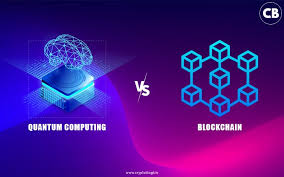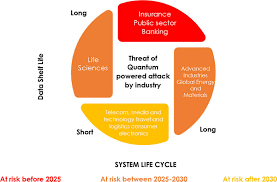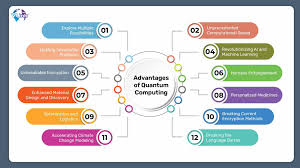Quantum Computing and Its Potential Impact on Blockchain Security

Introduction
Blockchain technology has been praised for its ability to provide security, transparency and immutability in a decentralized ecosystem. From cryptocurrencies like bitcoin and Ethereum to applications in supply chain management, healthcare and voting systems, blockchain has revolutionized how we store and transmit information. However, as technology moves forward, there are also challenges that could undermine blockchain security. One of the most important threats on the horizon is quantum computing. This emerging field promises to provide much more computational power than the reach of classic computers , Which could potentially break the secret foundations of the blockchain . In this article, we will explore what quantum computing is, how blockchain security works today, the dangers of quantum computers, and possible solutions to protect decentralized networks in the future.
What is quantum computing?
Quantum computing is a field of computer science that uses the principles of quantum mechanics to process information. Unlike classic computers that use bits (0 or 1), quantum computers use qubits, which can represent both 0 and 1 at the same time through a phenomenon called superposition. This ability, combined with confusion (where qubits influence each other even when separated by large distances), allows quantum computers to perform certain types of calculations faster than classic machines.
For example, tasks such as factoring huge basic numbers, which would take thousands of years for a classic supercomputer, could theoretically be solved by a fairly powerful quantum computer within hours or even minutes. While it promises advances in medicine, logistics and AI, it also poses a direct threat to encryption systems that rely on the difficulty of such problems.
Blockchain security today: a cryptographic Foundation
Blockchain security is largely based on cryptographic algorithms that protect transactions and ensure trust in the system. The two basic methods used in most blockchains are::
Hash functions (SHA-256 in bitcoin):
These are one-way mathematical functions that convert input data into strings of fixed length . Hash functions are used in mining, digital signatures, and ensuring data integrity.
Public key cryptography (Oval Curve Digital Signature algorithm-ECDSA – :
It is used to generate wallet addresses and secure transactions. This ensures that only the owner of the private key can sign a transaction, while everyone else can verify it using the public key.
Both of these systems are protected against conventional computers because they rely on problems that are virtually impossible to solve in due course . However, quantum computers threaten to break down these assumptions .
How quantum computers threaten blockchain
The threat to blockchain systems from quantum computing can be summarized in two major areas:
1. Breaking public key encryption
Most blockchains rely on ECDSA to verify ownership of funds. With classic computers, it is computationally impossible to get a private key from a public key. However, a quantum computer running a noise algorithm can theoretically break the problem down into a fraction of the time. This means that an attacker with access to a powerful quantum machine can steal private keys, impersonate wallet owners, and sign fraudulent transactions.
2. Break hash functions
While hash functions are more resistant, they are not fully immune. Quantum computers can use Grover’s algorithm to find collisions (two inputs generating the same hash) compared to classic computers. Although it does not completely break hashing, it can reduce the effective security level of algorithms such as SHA-256, forcing the blockchain system to adopt a stronger version .
Timeline of quantum threats
It is important to note that quantum computers capable of breaking down blockchain cryptography do not yet exist. Existing quantum machines, built by companies such as Google, IBM, and IonQ, are still in the early stages and can only handle a limited number of qubits with high error rates. Estimates vary , but experts believe that within 10-20 years, large-scale quantum computers can emerge with the ability to challenge existing cryptographic standards.
This timeline creates both urgency and opportunity. Blockchain developers have time to develop defenses, but waiting longer can weaken networks.
Real-world risks to Cryptocurrencies
If quantum computers become powerful enough, here are some specific threats that blockchain networks may face:
Wallet theft: hackers can get private keys from public addresses and withdraw funds.
Transaction falsification: fraudulent signatures can be made, undermining trust.
51% attacks with quantum advantage: miners with access to quantum machines can obtain disproportionate hashing power.
Loss of invariance: historical data can be tampered with if encryption protections are undermined.
These threats underscore the importance of transitioning to quantum-resistant encryption before the emergence of large-scale quantum systems.
Quantum-resistant cryptography: a solution in development
Researchers and blockchain developers are already working on cryptographic methods that can withstand quantum attacks. Some promising areas include::
Lattice-based encryption:
Uses complex mathematical structures that are considered resistant to both classical and quantum attacks.
Hash-based signature:
Instead of relying on elliptic curves, these systems use hash trees to generate secure signatures.
Multivariate polynomial encryption:
Multivariate relies on solving systems of polynomial equations, a difficult problem for quantum machines.
Code-based encryption:
Uses error correcting codes as the basis for encryption and decryption .
These methods fall under the umbrella of post-quantum cryptography (pqc), which is being standardized by organizations such as the National Institute of standards and technology (NIST).
Ongoing efforts to secure the blockchain against quantum threats
Several blockchain projects are already exploring or implementing quantum safe measures:
Ethereum 2.0 and post-quantum research: discussions are ongoing about integrating quantum-resistant algorithms .
Bitcoin Core developers: monitor NIST PQC progress to consider possible future upgrades.
Quantum-resistant blockchains (e.g., QANplatform, Quantum-Resistant Ledger): built from scratch with post-quantum cryptography in mind .
These efforts show that the blockchain community is not ignoring this issue but is actively preparing for a quantum future .
Quantum computing as an opportunity, not just a threat
Although quantum computing poses risks, it can also bring blockchain opportunities:
Quantum-safe communication: ensuring the transfer of data related to tampering using the quantum key distribution (QKD).
Fast consensus mechanisms: quantum algorithms can improve transaction validation.
Enhanced security model: blockchain can integrate quantum-based random number generation for strong security.
Thus, instead of just being afraid of quantum progress, the blockchain industry can leverage them for innovation.
Preparing investors and consumers for the quantum future
For everyday consumers and investors, quantum debate can feel abstract. However, awareness is very important . Wallets and exchanges can eventually move to quantum safe standards, and customers should be prepared to move their assets if needed . Especially long-term crypto investors will have to figure out how projects are adapting to this challenge, as coins that fail to adopt quantum-resistant measures can lose trust and value.
Forecasts for blockchain security in the quantum world
Looking forward, we can expect the following developments:
Gradual transition to quantum-safe algorithms across large cryptocurrencies.
Hybrid cryptographic systems that use both classical and quantum-resistant methods during transition .
The rise of new quantum safe blockchains that can rival today’s Giants.
Increased regulatory interest in ensuring the security of digital assets against Quantum risks.
The blockchain industry has always thrived on adaptation, and quantum risk will not be different.
Result
Quantum computing represents one of the greatest technological advances of our time and one of the greatest potential threats to blockchain security. While today’s encryption systems are protected by existing quantum machines, the acceleration of innovation means blockchain developers can’t afford to ignore threats. By embracing post-quantum cryptography, creating awareness and innovating with new quantum-resistant solutions, the blockchain industry can continue to thrive in the face of this challenge.
The future of blockchain in the quantum world isn’t just about survival—it’s about change. If handled correctly, quantum computing can push the blockchain into its next evolutionary phase, ensuring that decentralized systems remain safe, reliable and flexible in the coming decades .







